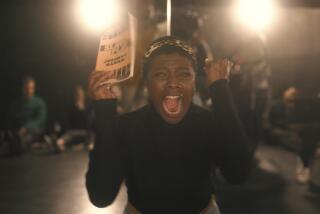Writer is stilled, but not his song
His ending had the kind of stinging resonance we’ve come to expect from his plays.
After delivering to the world the last installment of his 10-play cycle -- a decade-by-decade grappling with 20th century African American life -- August Wilson disclosed in August that he had been diagnosed with terminal liver cancer.
The news stunned the American theater community. And in Los Angeles, where “Radio Golf,” the culminating work of his epic project, was playing at the Mark Taper Forum, a sense of historical gravity surrounded what seemed likely to be Wilson’s final dramatic offering.
For a writer who stressed the necessity of African Americans reclaiming their cultural song -- a song of sorrow and rejoicing emanating from the embrace of the dislocated past -- the timing of the news had uncanny force.
In “Joe Turner’s Come and Gone,” the character of Bynum, a “conjure man” in his early 60s who binds lost souls together, waits expectantly for a supernatural sign that his “song had been accepted and worked its full power in the world,” for only then can he “lay down and die a happy man. A man who done left his mark on life.”
It took a quarter-century for Wilson to complete his song, which he began in 1979 with an early version of “Jitney,” the play that gave him the courage to declare himself a playwright. But there’s no doubting the magnitude of his accomplishment: two Pulitzer Prizes, a Tony Award and seven New York Drama Critics Circle Awards.
Wilson, who died Sunday in Seattle at age 60, stands alongside the foremost 20th century American dramatists, Eugene O’Neill, Arthur Miller and Tennessee Williams. Though some may argue that Wilson never wrote a play as great as “Long Day’s Journey Into Night,” “Death of a Salesman” or “A Streetcar Named Desire,” his finest works, “Fences,” “The Piano Lesson” and “Joe Turner’s Come and Gone,” have become pillars of modern American drama.
Even more impressive is the high quality that runs throughout the cycle, a consistency that separates Wilson from his illustrious predecessors. Their highs may have been higher, but their lows were definitely lower -- and more frequent. O’Neill’s boundless ambition resulted in some tone-deaf drama; Miller never equaled his early masterpiece, “Death of a Salesman”; and Williams’ late career remains more or less a car wreck.
It’s true that Wilson never had the international reputation of his nearest contemporaries, Sam Shepard and David Mamet, whose work, feeding off the alternative energies of the off- and off-off-Broadway movements, helped refashion the form and texture of contemporary playwriting.
Indeed, there’s nothing revolutionary about Wilson’s dramatic style. His work found a comfortable home on Broadway in the ‘80s and ‘90s in large part because of its familiar theatrical form. One could argue that the realism of his typically one-set plays might have seemed quaint had the characters been white and the subject matter something other than the tinderbox of America’s racial politics. But, then, that is to imagine a very different playwright, one whose content was not the breakthrough that his undeniably was for African Americans unaccustomed to seeing their lives represented so faithfully on Broadway.
Wilson often referred in interviews to James Baldwin’s call for a “profound articulation of the black tradition,” and this imperative fueled his artistic journey with a sense of public mission. “I am trying to write plays that contain the sum total of black culture in America, and its difference from white culture,” he explained to an interviewer. “Once you put in the daily rituals of black life, the plays start to get richer and bigger. You’re creating a whole world in the process of telling your story, of writing this character. Once you place him down in his environment, you have to write about his whole philosophical approach to life. And then you can uncover, from a black perspective, the universalities of life.”
Wilson was first and foremost a master storyteller, though not in the sense that his plots are so compelling. Characteristically, the dramatic action of his work stagnates before lurching violently forward, sometimes awkwardly, sometimes unconvincingly. Instead, the narrative drive stems from the presence of so many natural raconteurs in his plays, men and women whose life experience demands communal sharing and who find relief if not pleasure in the act.
Generous to a fault with his characters, Wilson allowed them ample opportunity to give voice to their hard-won experience. The plays were composed as a series of verbal arias, written not in high-flown poetic language but the idiomatic music of the street, which for Wilson (with the exception of the Chicago-based “Ma Rainey’s Black Bottom”) was Pittsburgh’s Hill District, where he grew up and educated himself into being a poet.
A high school dropout at 15, Wilson claimed to know little Shakespeare and said he discovered the European and American masters only after he had begun writing for the theater. He credited the “four Bs” with shaping his aesthetic -- the blues, fiction writer Jorge Luis Borges, playwright Amiri Baraka (author of “Dutchman”) and the painter Romare Bearden. He later acknowledged two other formative Bs: Baldwin and the playwright Ed Bullins. Among white playwrights, he felt a close kinship to Athol Fugard, the great South African playwright whose career remains a testament to the warping political reality of apartheid.
A man of many moods and contradictions, Wilson wasn’t afraid to challenge the status quo, even when personally benefiting from it. His fiery call for an autonomous black theater movement, which culminated in a highly publicized 1997 debate in New York’s Town Hall with artistic director and critic Robert Brustein, failed to adequately account for the fact that Wilson continued to rely on mainstream (i.e., “white”) institutions to develop and produce his works. Or that the black actors and directors he had so closely allied himself with -- most notably his mentor Lloyd Richards, the former artistic director of both the Yale Repertory Theater and the Eugene O’Neill Theater Center -- found colorblind casting to be not only personally liberating but also a professional value worth fighting for.
Wilson’s ability to inhabit such a full spectrum of positions and possibilities may have weakened some of his arguments in the debating hall, but this pattern of mind served him well as a dramatist. Theater thrives on conflict, particularly internal conflict, and the protagonists of his plays are rife with them. The struggle is invariably as psychological as it is sociological.
In his best work, Wilson complicates our relationship to his leading male characters. They are ambiguous figures, grappling with the victimization of being black in white-dominated America while wreaking their own destruction in an effort to uplift themselves to less oppressed and impoverished ground.
Consider Troy from “Fences,” the ex-baseball player who has unflaggingly supported his family as a garbage man in conformist postwar America. As noble as this hardworking patriarch is, it’s hard not to wince at the brutal way he treats his family, denying one of his sons a football scholarship and asking his wife to accept the baby of his mistress. Or the titular character from “King Hedley II,” a multifaceted and charismatic man who should have the world at his feet but instead robs a jewelry store to make the down payment for his own kung fu video store.
Though conscious always of the historical division between white and black America and its deleterious repercussions, Wilson refused to paint in black and white. While reminding us of the roots of our 20th century racial nightmares (whether it’s Jim Crow fallout or ghetto blight), he went to great lengths to reveal the ways men and women contribute to their own tragedy or transcendence.
The list of African American actors who owe a debt to Wilson is staggering -- Charles S. Dutton, James Earl Jones, Mary Alice, S. Epatha Merkerson, Angela Bassett, Ruben Santiago-Hudson, Viola Davis, Brian Stokes Mitchell, Leslie Uggams and L. Scott Caldwell, to name just a few. His works have given to each of them, in starring and supportive roles alike, the chance to reveal onstage the hopes and heartbreak of an embattled life.
Yet even more powerful than their individual marks as characters was the way the playwright threaded their existences into living, breathing communities. Whether under the direction of his early champion Richards or, later, Marion McClinton, the plays offer actors the truest experience of ensemble performance in our time, the chance to join what Wilson called their characters’ “wail and whelp of joy” to the larger symphony of history.
Charles McNulty will become The Times’ theater critic later this year.
More to Read
The biggest entertainment stories
Get our big stories about Hollywood, film, television, music, arts, culture and more right in your inbox as soon as they publish.
You may occasionally receive promotional content from the Los Angeles Times.











